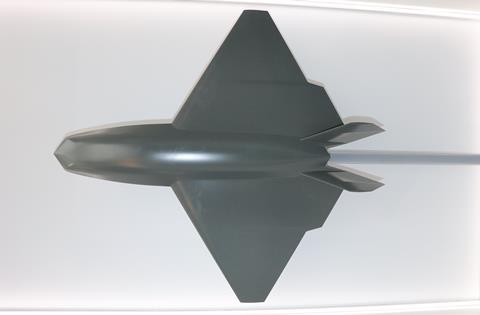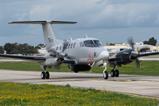BAE Systems has revealed the design of an autonomous collaborative platform (ACP) demonstrator which it aims to fly within the next two years.
Displayed as a sub-scale model at the World Defense Show near Riyadh, Saudi Arabia, the aircraft builds on the company’s earlier work in designing a Concept 2 vehicle unveiled in July 2022.
“We have been carrying on our many decades of investment in uncrewed systems, and are displaying our latest iteration of an ACP concept,” Steve Reeves, head of business development and strategy (platforms) at BAE’s FalconWorks technology accelerator, tells FlightGlobal.

BAE envisions such a platform “working in close harmony with current fast jets such as [the Eurofighter] Typhoon and the next generation of aircraft that come along”, he says.
Relying on the integration of artificial intelligence, the attritable platform would feature so-called goal-based autonomy. Roles could include intelligence, surveillance and reconnaissance, and electronic attack, with the asset also potentially to carry air-to-surface and air-to-air weapons within two internal bays.
The single-engined concept is comparable in size to BAE’s Hawk advanced jet trainer. Reeves says the internally-funded design will have subsonic performance, electric actuation, and some use of low-observable features.
“The real driver for this is to generate affordable combat mass, because the price point is going to be so important for our customers,” Reeves says. “You could end up with more than one platform, and being able to self-organise,” he adds of a likely concept of operations.
To use a conventional runway, an ACP could have an operational radius of 1,500nm (2,770km), and be stored within a container and only assembled and deployed when required. “We think that the ability to operate at range is important, with the ability to loiter for several hours,” he says.
“We have a programme laid out until it gets to first flight within two years. To take the programme much further, we are going to need a partner to help us develop the programme, and develop it in the right direction.
“We are actively looking for industrial partners to be able to come on board, so that we can produce the very best product in the best timescale.”
Reeves notes that the ‘brain’ of such a system also could be applied to other platforms, including those not manufactured by BAE.
“This fits neatly into the sort of air power that most air forces around the globe wish to own, because of its size and range,” he adds.
Multiple nations are pursuing the development of such an adjunct capability for their advanced fighters, with US efforts in this area referred to as collaborative combat aircraft. The UK Ministry of Defence, meanwhile, is due to publish its ACP strategy document in the near future. It is eyeing the technology outside of the Global Combat Air Programme activity now under way with Italy and Japan.































